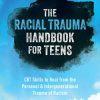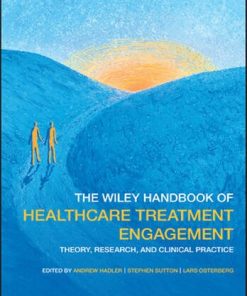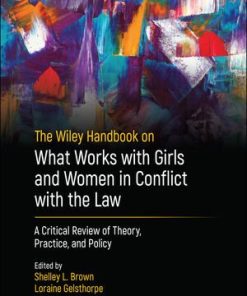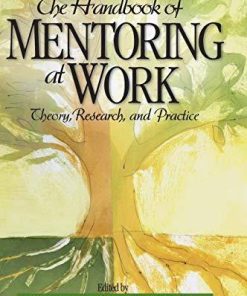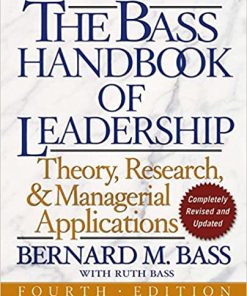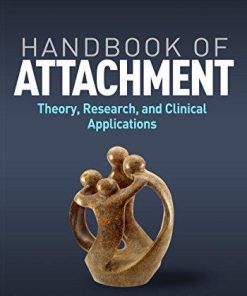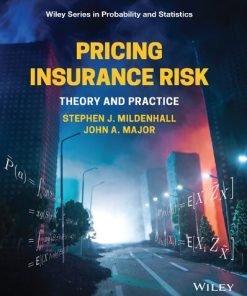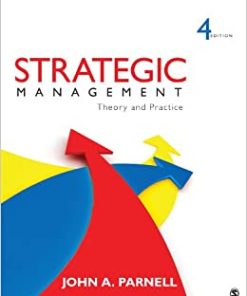(EBook PDF) The Wiley handbook of what works in violence risk management theory research and practice 1st edition by Stephen Wormith 1119315972 9781119315971 full chapters
$50.00 Original price was: $50.00.$25.00Current price is: $25.00.
The Wiley handbook of what works in violence risk management: theory, research, and practice 1st edition by J. Stephen Wormith – Ebook PDF Instant Download/DeliveryISBN: 1119315972, 9781119315971
Full download The Wiley handbook of what works in violence risk management: theory, research, and practice 1st edition after payment.
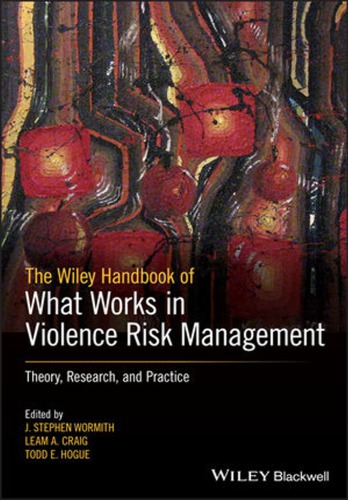
Product details:
ISBN-10 : 1119315972
ISBN-13 : 9781119315971
Author: J. Stephen Wormith
The Wiley Handbook of What Works in Violence Risk Management: Theory, Research and Practice offers a comprehensive guide to the theory, research and practice of violence risk management. With contributions from a panel of noted international experts, the book explores the most recent advances to the theoretical understanding, assessment and management of violent behavior. Designed to be an accessible resource, the highly readable chapters address common issues associated with violent behavior such as alcohol misuse and the less common issues for example offenders with intellectual disabilities.
The Wiley handbook of what works in violence risk management: theory, research, and practice 1st Table of contents:
Part I: Introduction
1 An Overview of Violent Behaviour from Aggression to Homicide
Introduction and Overview
Definitions of Violence and Aggression
The Magnitude and Scope of Violence in Modern Society as Illustrated by Homicide
Theories of Aggression and Violence
Assessment and Prediction of Violent Behaviour
A Collective Response: Three Tiers of Violence Crime Prevention
Future Directions: Global and Local
References
2 What Do We Know About Violent Offending Behaviour?
Overview
Rates of Occurrence
Explanations and Theory Related to Violent Behaviour
Types of Violence
Associated Contributors – Person‐Based
Associated Contributors – Contextual Factors
Summary
References
3 What Works with Violent Offenders
Introduction
Reducing Aggression and Violence
Conclusion
References
Part II: What Works in Violence Risk Assessment
4 From Predicting Dangerousness to Assessing and Managing Risk for Violence
Introduction
Foundation Issues
Approaches to Assessing Risk for Violence
Violence Risk Schemes
Summary and Conclusion
References
5 Violence Risk Formation
Introduction
The Relationship Between Formulations and Actuarial Measures of Risk
Top Down and Bottom Up Approaches to Looking at the Data
Making Logical Inferences Based on the Nomothetic Literature About the Individual Case
The Turn Towards Strengths‐Based Practice
Formulation as Causal Modelling Linking Evidence to Practice
Sequential Analysis
Domains and Types of Causal Factor in Formulations
Fictional Case Study
Conclusions
References
6 Predicting Violent Reoffending with the VRAG‐R
Introduction
Defining Risk Assessment and Actuarial Risk Scales
Summary of VRAG and VRAG‐R Development and Research
Overview of Controversies and Future Directions for Actuarial Risk Assessment
Summary and Next Steps
Acknowledgement
References
7 Structured Professional Judgement in Violence Risk Assessment
Introduction
SPJ Assessment Tools
SPJ General Violence Assessment Tools
Future Implications
Ethical Considerations
Conclusions
References
8 Intimate Partner Violence Risk Assessment and Management
Introduction
The Criminal Justice Response to IPV
Risk, Need, and Responsivity
The Risk Principle and IPV Risk Assessment
The Need Principle and IPV Risk/Need Factors
The Responsivity Principle and IPV Treatment
Implementing RNR in Threat Assessment
Conclusion
References
9 Sexual Violence Risk Assessment
Introduction
The Methodology of Sexual Violence Risk Assessment
The Different Generations of Risk Assessment and the RNR‐Model of Offender Rehabilitation
Second‐Generation ARAIs
Third‐Generation ARAIs
Structured Professional Judgement
Conclusions
References
10 Personality‐Based Violence Risk Assessment
Introduction
Multiscale Self‐Report Inventories
Conclusions on the Use of Multiscale Personality Inventories in Violence Risk Assessment
Hare PCL‐R and PCL: SV
Predictive Accuracy for Recidivism: Implications for Risk and Need
Therapeutic Responses of Psychopathic Offenders: Implications for Responsivity and Violence Risk Management
Conclusions on Use of the Hare PCL‐R and Its Variants in Violence Risk Assessment
Diagnostic Approaches
References
11 Assessing Risk for Violent, General, and Sexual Offending in Adolescents
Introduction
Adolescent Development and Its Relevance to Risk Assessment
Evidence‐Based Risk Assessment Tools
Emerging Risk Assessment Tools
Psychopathic Features and Adolescent Risk Assessments
Future Directions
Conclusions
References
Part III: What Works in Specialty Clinical Assessments
12 The Importance of Understanding Anger in the Clinical Assessment of Violence
Introduction
Assumptions About Anger
The Clinical Assessment of Anger
The Psychometric Assessment of Anger
Conclusions
References
13 Gang Violence Prevention Efforts
Introduction
Define and Monitor the Problem
Risk and Protective Factors: Socio‐Ecological Model
Prevention Programmes
Dissemination and Implementation of Programmes and Strategies
Discussion
References
14 Terrorism and Ideological Violence
Introduction
The Magnitude and Extent of Ideologically‐Based Terrorism: a Post 9/11, a Brief Review
Conclusion
References
15 Assessing the Risk and Treatment Needs of People Who Perpetrate Intimate Partner Violence
Introduction
What Is the Nature of IPV and Who Are the Perpetrators?
How Is IPV Best Explained?
Are People Who Commit IPV a Heterogeneous Group?
Applying Evidence in the Risk Assessment of IPV Treatment Need
Functional Assessment
Conclusion
References
16 Aggression from a Psychobiological Perspective
State‐of‐the‐Art of Violence Risk Prediction
A Reductionistic Approach to Understanding Behaviour: General Considerations
Science, Levels of Organization and the Resultant Change in Classification of Psychopathology
A Brief Primer on Molecular Biology and Molecular Genetics
Epigenetics
Aggression Theory, Biological Systems and the Brain
Existing Support for the Model
Empirical Support Summary
Future Perspectives
References
17 Assessment of Risk of Violent Offending for Adults with Intellectual Disability and/or Autism Spectrum Disorder1
Introduction
Offenders with Intellectual Disabilities
Offenders with ASD
Conclusions
References
Part IV: What Works in Violence Intervention
18 Risk‐Reducing Treatment inHigh‐Risk Psychopathic and Violent Offenders
Introduction
The Target Client Group
Theoretical Influences on Treatment and the Main Phases of Treatment
Assessment of Dynamic Factors for Treatment
Evaluating offenders’ Treatment Progress and Change
Programmes that Work with Violent Offenders
Do these Programmes Work?
How Does Treatment Work?
Treating Violent Offenders with Psychopathy
Conclusions
References
19 Anger Treatment with Violent Offenders
Introduction
Anger as a Relevant Violence Risk Factor
Anger Therapeutic Interventions as Violence Remedies
Implications and Conclusions
References
20 Managing Violent Offenders with a Personality Disorder
Introduction
The Link Between Personality Disorder and Violence
Formulation
The Role of Formulation in Violence Risk Management
Conclusions
References
21 Antisocial and Aggressive Behaviour Amongst Persons with Schizophrenia
Introduction
A Vicious Circle – Victimization and Aggressive Behaviour
References
22 Intimate Partner Violence Perpetrator Programmes
Introduction
Current Theoretical Models and Influences
The Gate‐Keepers
Partner Abuse Review of Domestic Violence Perpetrator Programmes
Reviews of the Effectiveness of Programmes
Conclusion
References
23 Interventions for Violent Offenders with Intellectual and Developmental Disabilities
Introduction
Prevalence of Aggression and People with IDD
Impact of Aggression for Patients, Staff and Services
Links Between Anger and Aggression
Treatment for Anger and Aggression
Psychopharmacological Treatment
Behavioural Interventions
Cognitive Behavioural Interventions
Conclusions
References
Part V: What Works in Violence Risk Management
24 Sexual Violence Risk Management
Introduction
Models of Sexual Offender Management
Sexual Offender Registration and Community Notification
Residency Restrictions and GPS Monitoring
Sexual Offender Civil Commitment
Circles of Support and Accountability
Conclusions
References
25 Effective Systems and Processes for Managing Violent Offenders in the United Kingdom and the European Union
Introduction
The Origins of Multi‐agency Working in England with Violent Offenders
Evidence of Effectiveness for MAPPA
The Extension of Multi‐agency Working with High‐Risk Offenders: Integrated Response, Integrated Service (IRIS)
Effective Systems for Managing Violent Offenders Who Travel Across Countries
Brexit and Challenges to Effective Information Exchange Across the EU
Conclusion
Acknowledgement
References
26 Beyond Core Correctional Practice
Introduction
Looking Inside the Black Box of Community Supervision
Training Programmes for Community Supervision Officers
Lessons Learned from Officer Training Programmes
Understanding Why Change‐Agent Supervision Can Work
How STICS Promotes RNR
Lessons from Psychotherapy Research
Conclusions
Acknowledgment
References
27 What Works in Risk Assessment in Stalking Cases
Understanding the Nature of the Stalking Phenomenon
Understanding What Drives Stalkers
The Expanding Evidence‐Base on Stalking Risk
Practical Risk Assessment in Stalking Cases
Practical Management in Stalking Cases
References
28 Managing Violent Offenders in the Community
Introduction and Overview
Issues in the Assessment of Violent Offenders
Community Supervision of Violent Offenders
References
People also search for The Wiley handbook of what works in violence risk management: theory, research, and practice 1st:
what is violence risk assessment
what is a workplace violence risk assessment
risk factors for violence in the workplace
risk factors for workplace violence in healthcare
what workplace violence event causes the most damage
Tags:
Wiley handbook,violence,risk management,theory,research,practice,Stephen Wormith
You may also like…
Psychology - Clinical Psychology
Uncategorized
The Wiley Handbook on What Works with Girls and Women in Conflict with the Law 1st edition
Management



